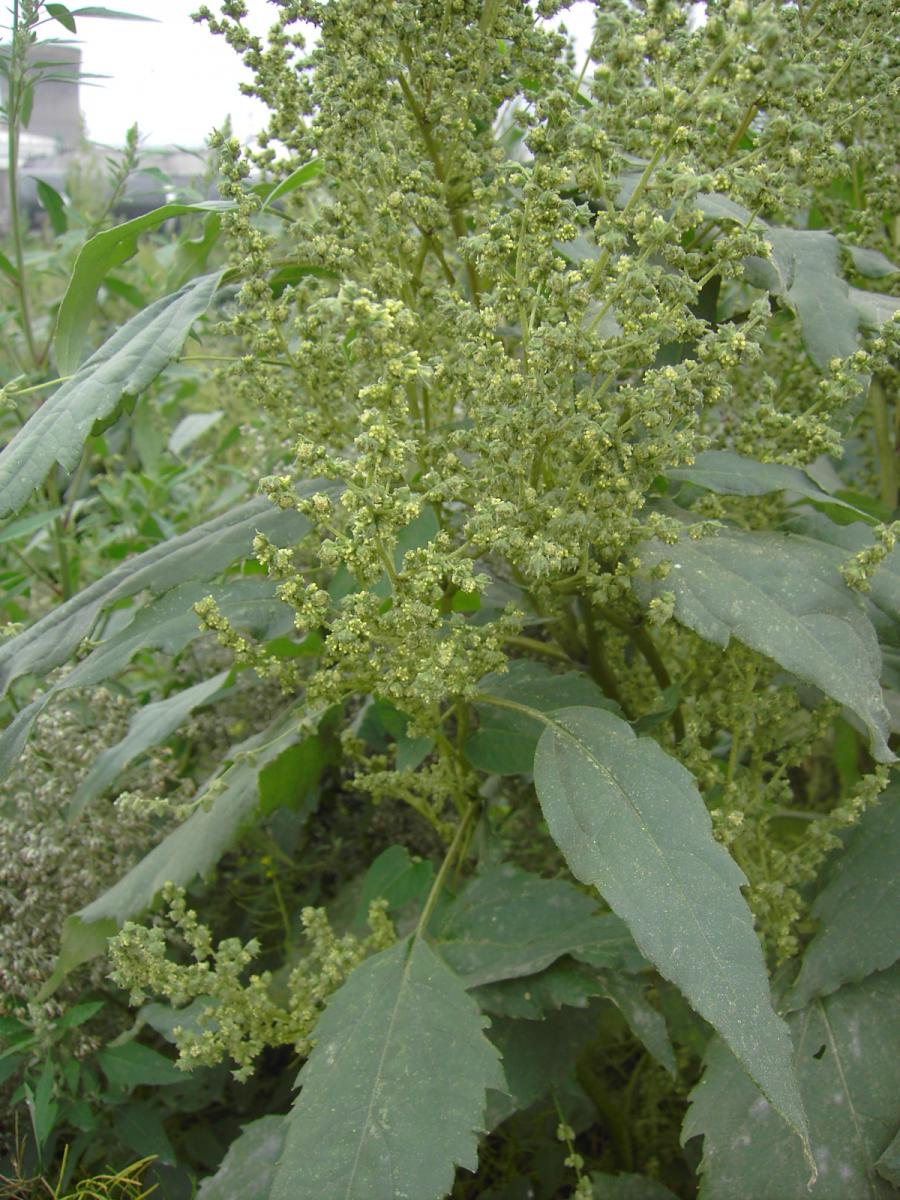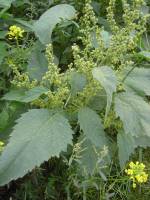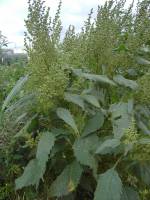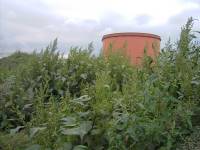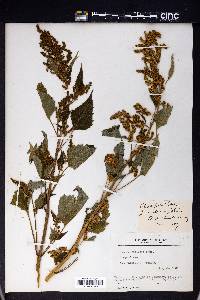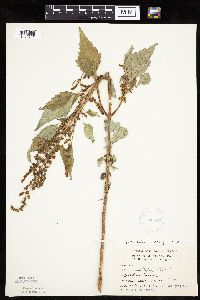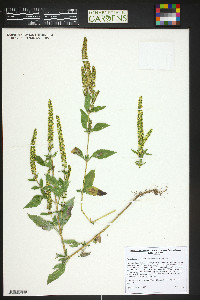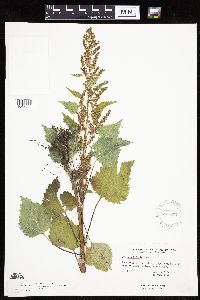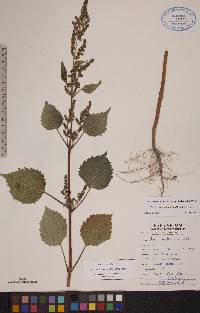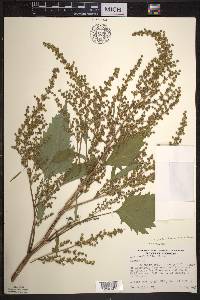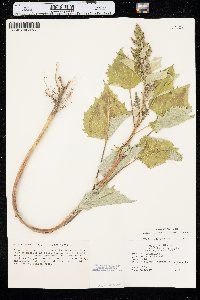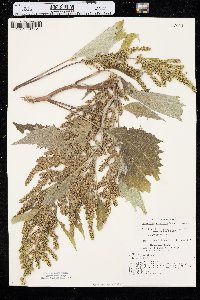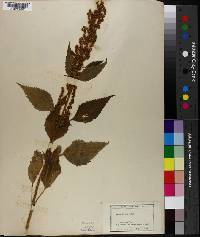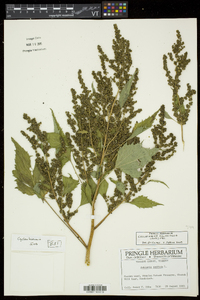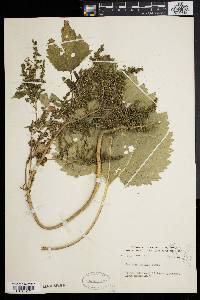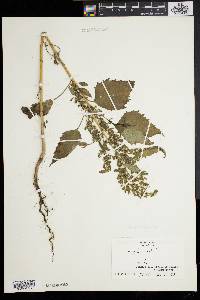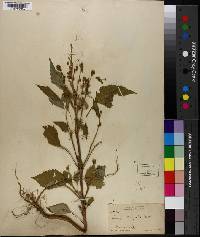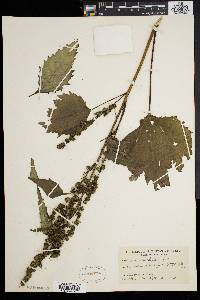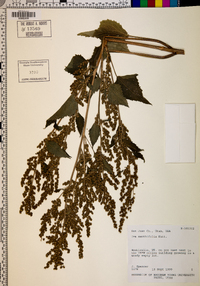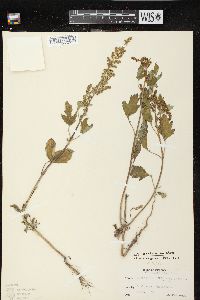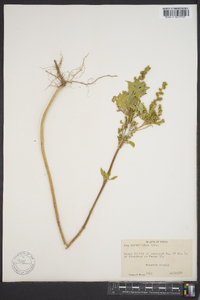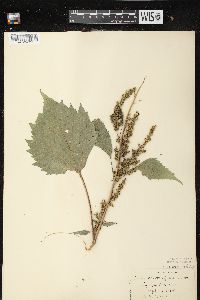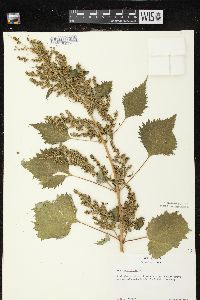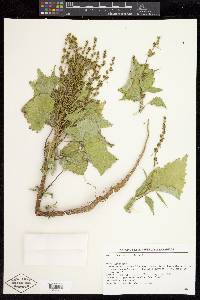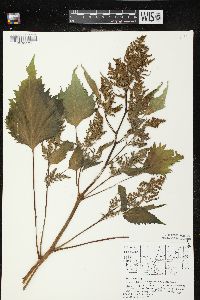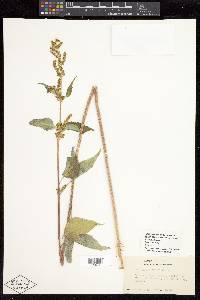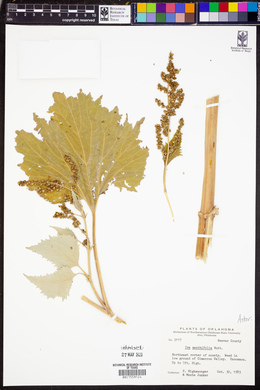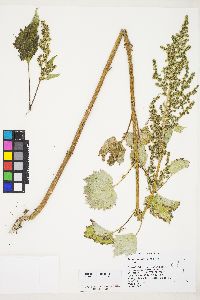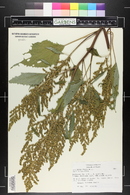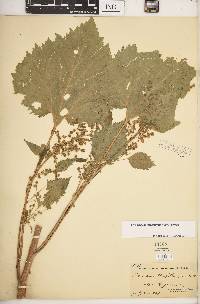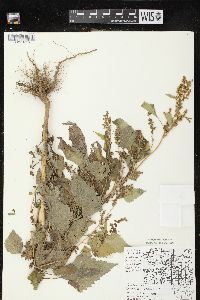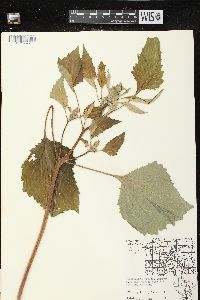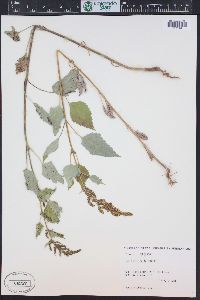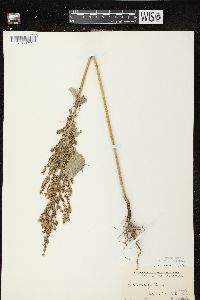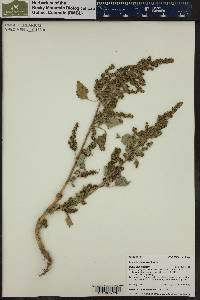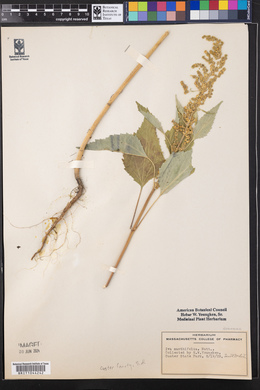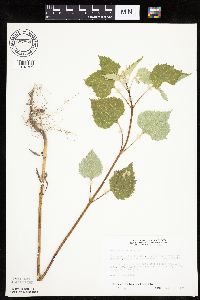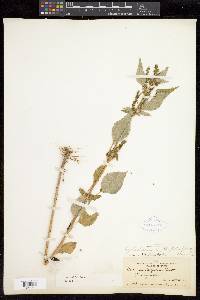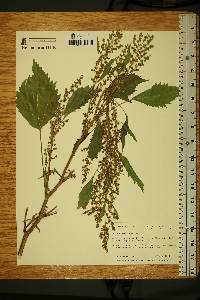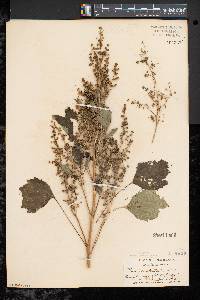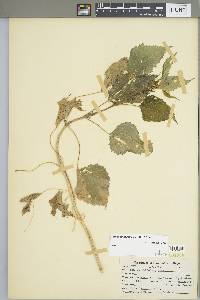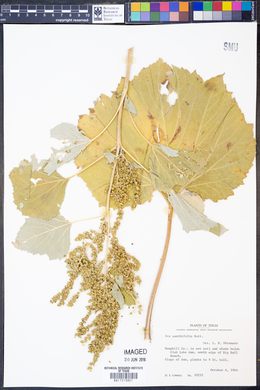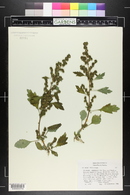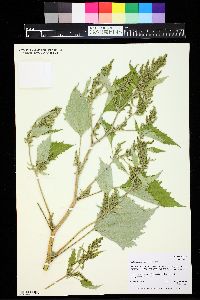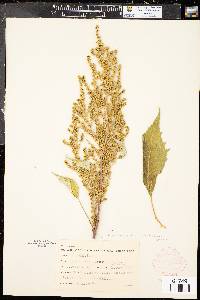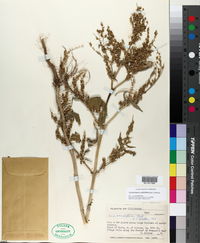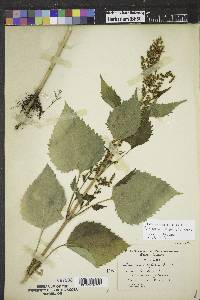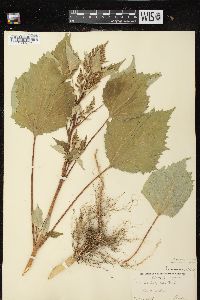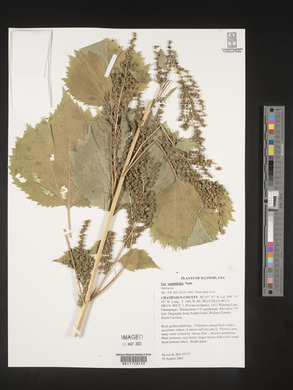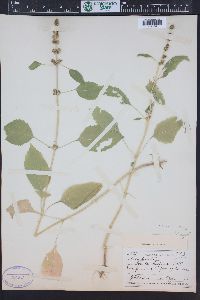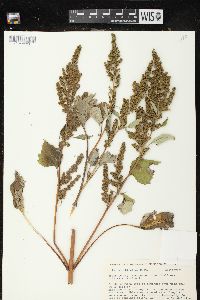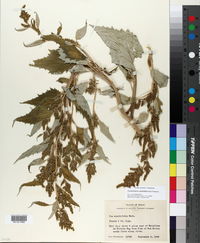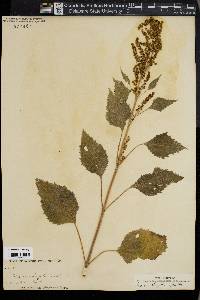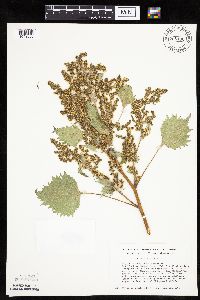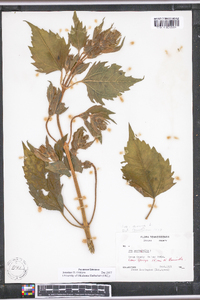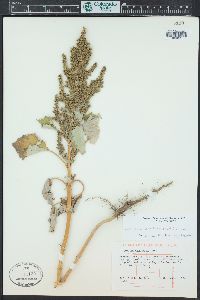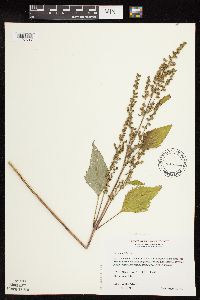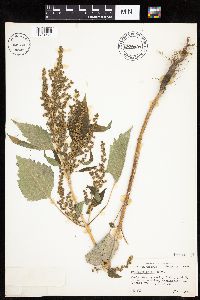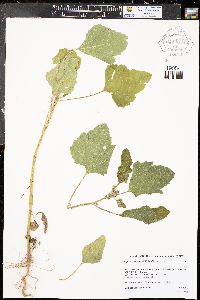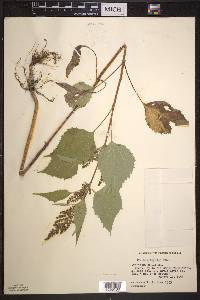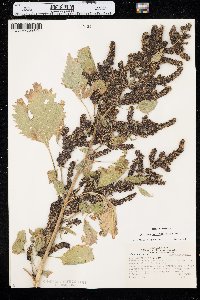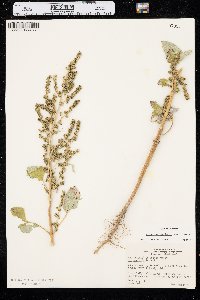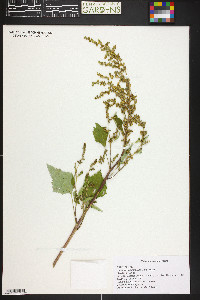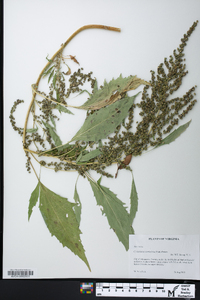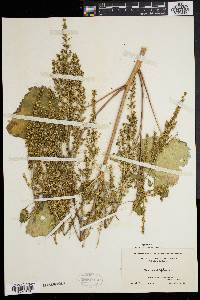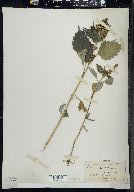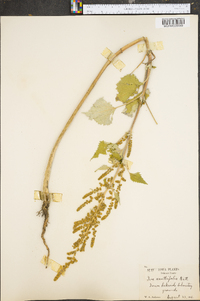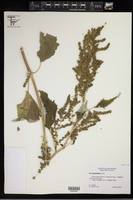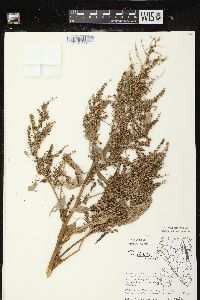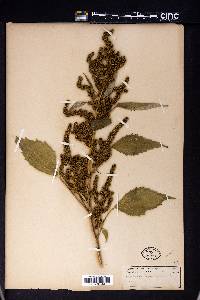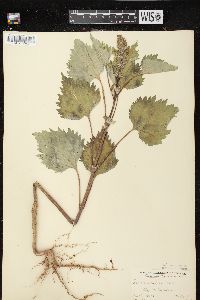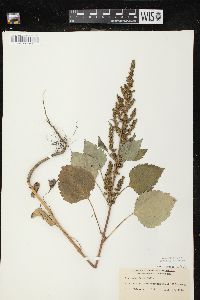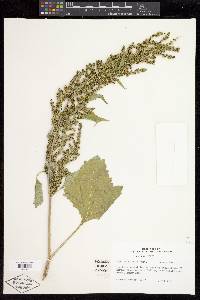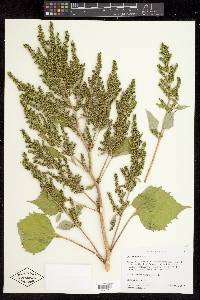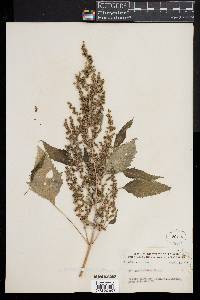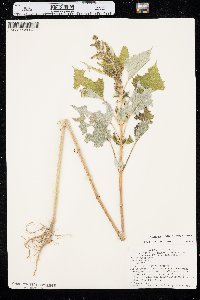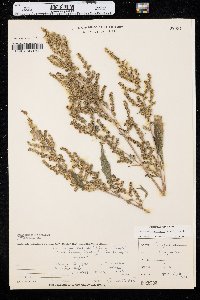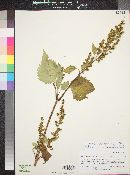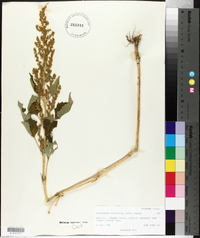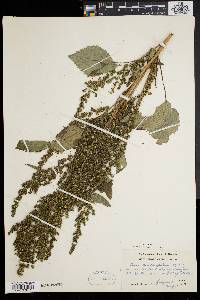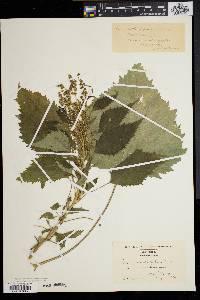
|
|
|
|
Family: Asteraceae
Carelessweed
[Euphrosyne xanthiifolia (Nutt.) A. Gray, moreIva xanthifolia Nutt., Iva xanthiifolia Nutt.] |
Leaves: petioles 1-7(-12+) cm; blades 6-12(-20+) × 5-12(-18+) cm. Peduncles 1-6(-12+) mm. Involucres 2-3 mm. Phyllaries: outer 5 ± herbaceous, sericeous to strigillose, inner scarious to membranous, glabrous or glabrate. Paleae 2-2.5 mm. Pistillate florets: corollas 0.1-0.5 mm, or 0. Functionally staminate florets: corollas 2-2.5 mm. Cypselae 2-2.5(-3) mm. 2n = 36. Flowering Jul-Oct. Disturbed sites: abandoned fields, bottomlands, flood plains, stream banks; 1-1300 m; Alta., B.C., Man., N.B., N.S., Ont., P.E.I., Que., Sask.; Ariz., Calif., Conn., Colo., D.C., Idaho, Ill., Ind., Iowa, Kans., Ky., Maine, Mass., Mich., Minn., Mo., Mont., Nebr., Nev., N.H., N.J., N.Mex., N.Y., N.Dak., Ohio, Okla., Oreg., Pa., R.I., S.Dak., Tex., Utah, Vt., Va., Wash., Wis., Wyo. Cyclachaena xanthiifolia is thought to be native to North American prairies and is evidently adventive east of the Mississippi River and in western states. It was recorded once from California as a weed in commercially grown carrots (specimen in CAS).
FNA 2006, Kearny and Peebles 1979, Heil et al 2013 Duration: Annual Lifeform: Forb/Herb General: Annual herbs, 30-120(-200) cm tall; stems erect and usually unbranched. Leaves: Mostly opposite, the distal leaves sometimes alternate; on 1-7 cm petioles; blades deltate, ovate or rhombic, 6-12 cm long and often as wide, with toothed margins; surfaces usually gland-dotted, the upper surfaces also scabrellous to strigillose and lower surfaces canescent, at least when young. Flowers: Flower heads small, disciform, usually subsessile, and arranged in spicate panicles; involucre (ring of bracts wrapped around the flower head) turbinate to hemispheric, 2-3 mm high, the bracts (phyllaries) in 2 distinct series, each consisting of 5 phyllaries, the outer series herbaceous and sericeous to strigillose, and the inner series membranous and glabrous; pistillate florets 5, in a ring around the outside of the flower head, the corollas absent or vestigial, < 0.5 mm long; inner florets 5-20, functionally staminate, the corollas whitish, 2 mm long. Fruits: Achenes 2-3 mm long, plumply obovoid to obcompressed, finely striate, sparsely strigillose or hispidulous distally, lacking a pappus. Ecology: Found in disturbed sites, including abandoned fields, bottomlands, floodplains, and stream banks, from 5,200-9,000 ft (1585-2743 m); flowers July- October. Distribution: Throughout the US except in the southeastern states; north into the southern Canadian provinces; introduced to Europe. Notes: Look for a simple-stemmed annual herb with pairs of large rounded leaves with pointed tips and toothed edges near the bottom of the plant, and a panicle of many small flower heads at the top. It superficially resembles an Ambrosia, with its small inconspicuous flower heads, but the achenes that follow are not spiny like in Ambrosia. Cyclachaena xanthiifolia is thought to be native to North American prairies and is supposedly adventive east of the Mississippi River and in western states. The plant causes contact dermatitis in some people, and the pollen is a cause of hay fever. Cyclachaena is a monospecific genus. Look for this taxon under Iva xanthiifolia in older texts. Ethnobotany: Poultice of plant applied to boils; used to heal the castration incision in sheep, to treat coughs, flu, and used as protection from witches. Etymology: Greek cyclo-, circular, and Latin achenium, achene; alludes to the achenes produced by the ring of 5 pistillate florets in each fruiting head; xanthifolia means that the leaves resemble those of the genus Xanthium. Synonyms: Iva xanthifolia, Cyclachaena xanthiifolia, Iva xanthiifolia Editor: AHazelton 2015 Coarse annual weed 0.5-2 m; stem simple and glabrous below, viscid-villous in the infl; lvs chiefly opposite (only some of the upper alternate), long-petiolate, ovate, often very broadly so, coarsely and often doubly serrate, trinerved or triplinerved, 5-20 נ2.5-15 cm, strigose- scaberulous above, paler and often finely sericeous beneath; infl large, paniculiform, the numerous heads subsessile, not subtended by bracts; invol 1.5-3 mm, its 5 subherbaceous bracts somewhat larger than the 5 more membranous receptacular bracts (like an inner invol) that partly enfold the glabrous or distally hispidulous achenes; cor of the pistillate fls less than 0.5 mm, or obsolete; 2n=36. Bottomlands and moist waste places; Wis. to B.C., s. to Tex. and N.M., and occasionally intr. eastward. Aug.-Oct. (Cyclachaena x.) Gleason, Henry A. & Cronquist, Arthur J. 1991. Manual of vascular plants of northeastern United States and adjacent Canada. lxxv + 910 pp. ©The New York Botanical Garden. All rights reserved. Used by permission. From Flora of Indiana (1940) by Charles C. Deam Reported by Hansen as found along a ditch in Tippecanoe County, and by Peattie as found in the Calumet District. Although I have not seen a specimen, I am admitting this species because there is little possibility of a wrong determination. |
This project was made possible in part by the Institute of Museum and Library Services [MG-70-19-0057-19].
Powered by Symbiota

